Celebrating the Anniversary of the Herstory Project
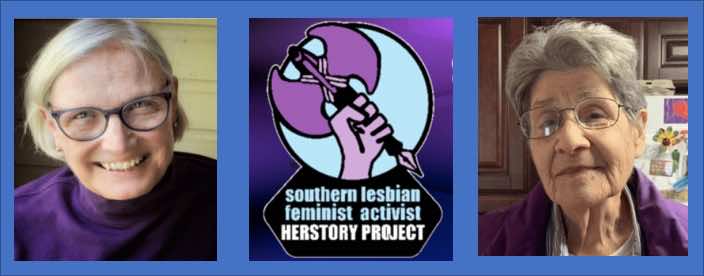
Rose Norman: It’s the second anniversary of the Herstory Project website launch on May 24, 2022, and we are sharing some of our memories about this herstory project that we started at Womonwrites in 2009. In particular, I want to acknowledge that this Herstory Project wouldn’t have happened without Womonwrites.
Merril, since you have such a long history with Womonwrites, almost twice as long as mine, and mine is 20 years, tell us about Womonwrites and the Herstory Project.
Many of the attendees were lesbian-feminist activists. This event was ripe ground for dykes
to burst into action when we realized that we had been left out of our own herstorical record.
Merril Mushroom: Womonwrites, the Southern Lesbian Writers’ Conference, which met from 1979 to 2019, was an annual event; and then, a twice-a-year event. It brought together women from at least twelve southeastern states, as well as women from other places. Plus, they held a large, planning meeting every year.
It was primarily, but not only, attended by women interested in writing, reading, and listening. Many of the attendees were lesbian-feminist activists. This event was ripe ground for dykes to burst into action when we realized that we had been left out of our own herstorical record.
The Impetus
Really, the whole impetus behind the Herstory Project was the bad behavior of some of the women from the Northeast and the West Coast who had come to the South to all sorts of women’s festivals, where they were very patronizing, demeaning, and bossy toward us. They didn’t treat us Southern dykes as equals.
I recall reading all of the prominent, feminist literature from the time, and a little bit of the lesbian literature that was also part of it. It was all about how the women from the Northeast and the women from the West Coast were the movers and the shakers. They were the ones that did everything. There was absolutely nothing about all of the activism that we had going in the Southeast. I was born and raised in the Southeast, such as it was. Then, I lived in New York City for ten years. I came back to the Southeast in 1973.
I didn’t like that we were excluded from the feminist narrative,
that there was nothing about our activism in the South.
There were consciousness-raising (CR) groups going on in Knoxville, Tennessee, where I settled. Projects came out of those CR groups to benefit women, such as battered women’s shelters. And women’s awareness about the obstetrics and gynecology (OBGYN) clinics, where there wasn’t any awareness (especially lesbian awareness); and reading groups and writing groups; and dances. We were trying to figure out how we could make our way into the society of NOW [the National Organization for Women], which was very exclusionary, At the time, NOW wouldn’t allow lesbians.
When I moved out to the country, I learned that the same thing was going on in Nashville, Tennessee, and in Florida. There was a tremendous, tremendous amount of feminist activism among lesbians and straight women in both of these Southern states. There was also a tremendous upsurge in lesbian activity because we were a little bit safer, as far as the law was concerned, than we used to be in the 1950s and the 1960s.
I didn’t like that we were excluded from the feminist narrative, that there was nothing about our activism in the South, and that people from the “big-city” places treated us like shit. I wanted somebody to do something about it, somebody who knew how to approach the gap. I talked it up a lot at the dyke conferences and at Womonwrites.
I’d get reports from women who worked at the music festivals that women put on. There was really bad stuff being said. One big organizer said, speaking of how she treated festival workers, “Oh, I’m bringing slavery back to the South.” She meant that all of the Southerners, musicians included, that worked for her festival didn’t get paid; whereas the dyke workers and musicians from the West Coast did get paid. Another time, women were playing bluegrass music, you know, kind of jamming; and the big dykes would walk by saying, “Ooh, do we have to listen to this?” I didn’t like that attitude! It wasn’t nice. It wasn’t respectful.
RN: Those comments about bluegrass music and bringing back slavery were heard at the Southern Women’s Music and Comedy Festival. We wrote about that in Lesbianima Rising (Sinister Wisdom 104).
MM: I talked and talked about things like that, and women would say, “Yeah, yeah, yeah.” When, you, Rose, retired from your job, everything began to take shape when you had time to work on it and to do everything. You are the most absolutely magnificent leader, organizer, doer, mover, and shaker that this world has ever seen!
Feminist Rumblings
All of those rumblings at Womonwrites kind of took shape. We had a big meeting, and we did a timeline of the activism. Women were astonished. Even women who lived here were astonished. “Oh my god, did we really do that?” We had a good long roll of butcher paper. Women got up, went over to the paper roll, and wrote things down as they remembered them. That was the foundation. Rose, what did you do then?
RN: I took notes. Today, I went back to look at some of those notes to try to think of a structure for our talk about the project, which has been going since 2009. That was the year before I retired. I was amazed at how quickly this whole project took shape.
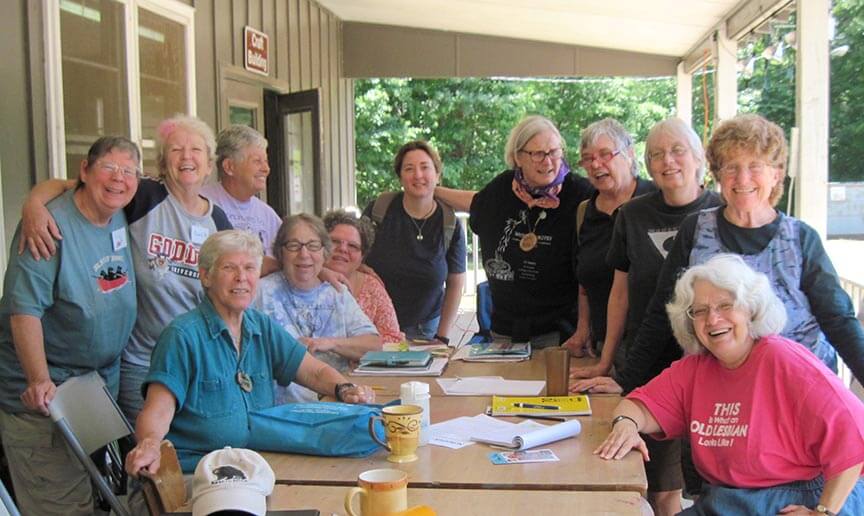
The Gist of Womonwrites
First, I want to go back to mention why Womonwrites was so critical to this happening. Womonwrites had been meeting annually since 1979; and starting in 1997, it met in both the spring and the fall of the year. In 2009, our Herstory Project started meeting there as a workshop. We had good attendance because any workshop with Merril’s name on it attracted women. I counted 22 women at the first workshop. Womonwrites drew lesbians from all over the Southeast, and it had pretty good attendance. They had 70 women at the very first Womonwrites in 1979, and during my years there, starting in the 1990s, we might have 90. We needed 90 to break even on our costs. One time when I was there, it was over a hundred, which is almost all the camp could hold.
MM: We had 136 one year. We were over our limit, and we had to find extra sleeping spaces.
RN: Wow, that’s amazing! It was a wonderful gathering. We write about Womonwrites in a couple of our special issues of Sinister Wisdom: “Womonwrites,” Sinister Wisdom 93 and Sinister Wisdom: “Womonwrites,” Sinister Wisdom 116.
I would like to talk about the diversity of women at Womonwrites, and not so much racial diversity. I think ten was the most women of color at any Womonwrites whenever I attended. That’s a lower percentage than the representation of people of color in Southern states.
MM: Race consciousness was always an issue, from the beginning all the way through to the end. It was always an issue one way or another, and we could probably spend the rest of our time talking only about that.
One of the things that is ignored when we talk about diversity is class diversity. Even though everybody that came was interested in writing, in listening to other women read their writing, and in participating in workshops done on writing, there was a huge diversity as far as ability and knowledge. Every woman was equally respected no matter how much of a beginner they were, and no matter how much of a professional they were.
We decided early on that we were not going to have speakers, and we were not going to have “important women” come in, you know, “stars” for everybody to bow at their feet. Every woman there was equal, no matter what her degree of ability or publishing or education. Many women were highly educated. Some were college professors. And some women did not finish high school… not a lot, but some. A couple of women were in professions that would maybe be looked down upon as far as making money, like waitresses and such.
Some women had mental conditions that required a little bit more care than others that didn’t have conditions like that. Everybody was very conscious of not running over anybody and not hurting anybody’s feelings. We would do what needed to be done. Sometimes, women volunteered for things they didn’t really know how to do. For example, if a woman signed up to work registration who really was not able or capable, we added someone to helo. You and I helped out with that. We took it on and did it forever after that! (Laughter)
RN: There was also some geographic diversity. Womonwrites met near Atlanta, somewhat central for the Southeast. It met every year at the same state park, approximately an hour from the Atlanta airport. It’s the busiest airport in the world, and very central for flying. We’d get women from all over the country even though mostly, they were from the Southeast. We had regional diversity, and also the education diversity.
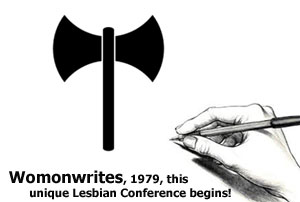
We forgot to mention that Womonwrites was “participant led.” It was unusual in that respect, being participant led. Not having speakers and all that means that whoever shows up at the planning meeting to volunteer gets to make it happen. Often, workshops were cooked up on site. Also, a lot of the same women came every year, year after year, and they knew what they were doing. They knew the camp, and they improved the camp. They built ramps to make buildings more accessible. Staying at the same camp is one thing that made it possible for it to last as long as it did: forty years. 2019 was the last Womonwrites. Also, as you commented, a lot of women were teachers.
MM: Elementary school teachers, preschool teachers, high school teachers, college professors…
RN: We hardly ever knew what women did for a living. Their work life was not what they talked about or wrote about. You got to know women in an unusual way because of their readings. Hearing women read their work, often about their personal lives, gives you a distinctive perspective. It was often not what you expected.
MM: I think women felt safe, lesbians felt safe. It was something that developed over a very short period of time. They felt safe to spill their hearts out, to speak honestly about themselves. Everybody there was so kind. I think that’s a particularly Southern thing. Nobody jumped on anybody; and no one negatively criticized women’s writing for the way they said or felt about something, even if the women didn’t agree. They were considerate, caring, and kind to one another. It lent an atmosphere of safety where we felt able to, at least on a personal level, let ourselves be vulnerable.
It was pretty miraculous what Womonwrites did.
I really think the Herstory Project is the descendant of Womonwrites.
We looked to our planners and to the women who did jobs as the jobs that became necessary. We didn’t have security workers for several years in the very beginning. Then there was a problem, which led to a discussion after the problem about how sometimes a woman might get in trouble in her cabin, such as fall in the shower or something. We determined that we needed to have a way to check on each other. We also wanted security to deter anybody outside of the campgrounds who might want to come in to rob us, which had happened a couple of times. We had a security planner ever after that.
At first, all the jobs were done by volunteers, and no woman was paid. During a big meeting, it was pointed out that the women who do the cooking and are always in the kitchen, and they don’t really have the chance to go to the workshops if they wanted. Therefore, they should get paid for their work. We also decided that the childcare worker, who took care of the kids and who had to be with the children most of the all day, should also get paid. We made those two positions into a paying job, and they remained the only paid positions. We felt good about that.
RN: It was pretty miraculous what Womonwrites did. I really think the Herstory Project is the descendant of Womonwrites. Even though Womonwrites doesn’t exist anymore, the Herstory Project does. Many of the women involved in the Herstory Project to this day are former Womonwriters who know how to work together from all those years of working together at Womonwrites.
Womonwrites had been going for thirty years in 2009, when we had that first Herstory Project workshop. The notes from that time say that “for our writing activity, the attendees constructed personal, historical timelines of their involvement in Southern, lesbian-feminist activism, 1965 to 1985.” That was the time frame for our beginning. The notes say that we had done something like this in 2008, and that’s when we did the big timeline on butcher paper that I took home. Now, can’t find that first timeline. I never found it.
MM: It was you!
RN: I felt so guilty about it that I tried to make up for it by working really hard on constructing a new timeline on a computer so that I couldn’t lose it.
MM: Rose, you’re coming out right now on tape about that. Nobody knew it was you. Nobody could figure out who it was that lost the butcher paper timeline. Thank you.
RN: The thing is, there was this roll of butcher paper in my office that I thought was the timeline. When I went to get it, it was some student project that I needed to discard. I don’t know if I threw away the wrong one or what.
MM: Well, look what you did without it. Wowee!
Calling for Contributors
RN: I’m amazed at how productive we were. After that first workshop, our notes say that you posted a call for contributors to Lesbian Connection in May. You also took the call for contributors to OLOC [Old Lesbians Organizing for Change] in summer of 2009. Was that a regional OLOC gathering or national?
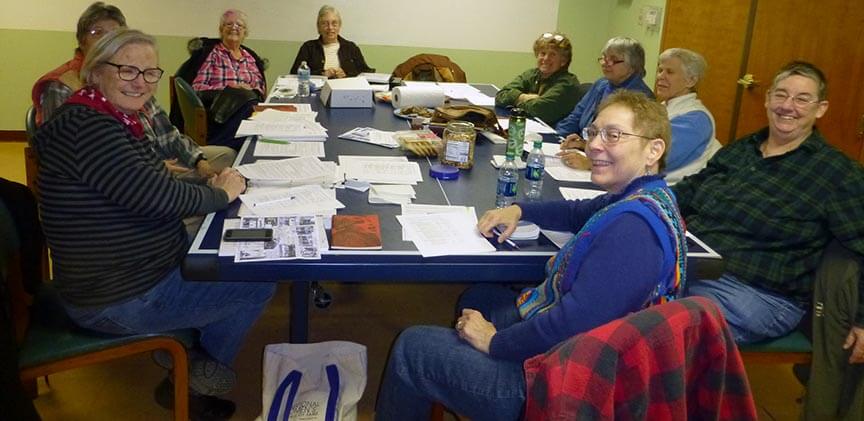
MM: It was national, and we couldn’t get anybody to do anything. How many years did we post the call for contributors?
RN: Well, not many, because…
MM: Because we didn’t get any, and we were banging our heads together…
Coming Together
RN: Here’s another thing that I thought was really important. In October of 2009, this is our very first year, the notes say that Merril describes the project purposes as follows:
- Collect as much information as possible about specifically lesbian-feminist activism in the Southeast, 1965 to 1985.
- Archive documents and other things that we collect, or find a suitable library archive.
- Publish our findings in some form.
And that’s what we did. That is what we did.
MM: You know why? Because we had excellent leadership and excellent workers.
RN: That’s exactly right. We had plenty of women who came up to the plate when it was time.
We were lesbian feminists, by golly, and we worked that way when we were looking to find information.
MM: Because we were Womonwriters, we knew how to work together. We had done it before in many different places and in many different ways. We were lesbian feminists, by golly, and we worked that way when we were looking to find information.
RN: So many of the women who attended Womonwrites did have a really impressive, activist history in lesbian-feminist activism. They knew what they were doing when it came to lesbian-feminist activism, and they knew who we could interview.
At that October 2009 workshop, the notes say that you had talked to Mandy Carter, who had said that she thought Duke would be interested in our archives because they already had the Atlanta Lesbian Feminists Alliance (ALFA) archives. We also thought about Georgia State University and the University of Florida.
In 2010, Beth York and I went to Duke [in Durham, North Carolina] specifically to look at the archives they had. Pretty quickly, it was clear that working with Duke was what we wanted. That’s the Sallie Bingham Center for Women’s History and Culture at Duke University.
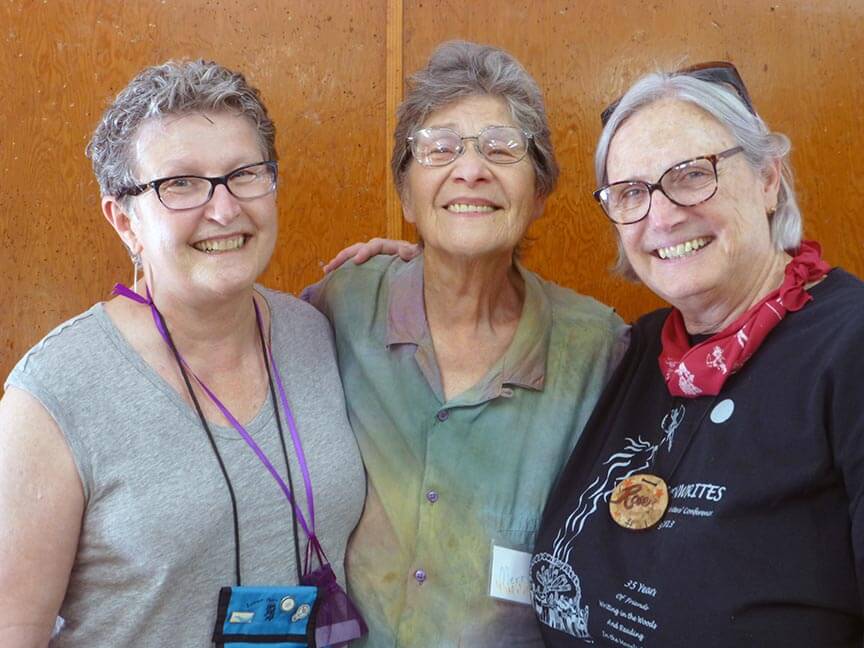
We were able to get the Womonwrites archives there as well as our Herstory Project archives. We got busy right away collecting and organizing the Womonwrites archives. Madison and Kelia, a couple in Nashville, did most of that work. Before the Womanwrite archives went to Duke, they were stored in Madison and Kelia’s garage.
We have been sending interviews to Duke University to archive since 2014. I looked this up, and 130 of our interviews are archived there now.
MM: Wow!
RN: I believe those are all the interviews used in the six special issues of Sinister Wisdom that we published from 2014 to 2022. I’ve done a whole lot more interviews for the Pagoda book, which will be archived in the coming year. We also continue to do new interviews as we develop the website. You’ve just interviewed Lenny Lasater and Jaye McNeil. Lorraine just interviewed Liz Hill.
Defining Our Process
Going back to our progress, I see that at the Womonwrites workshop in May 2010, we had 22 women. We were not getting what we needed from the call for contributors. We got inquiries, but we didn’t get stories. We thought that maybe if we posted an online survey, that would stimulate women to write about their activism. I knew how to do online surveys, and I tried that way of soliciting personal writings about lesbian-feminist activism in the South. From the beginning, we let the contributors define lesbian, feminist, activist, and South.
In 2010, we also tried to think of a better name than the Southern Lesbian Feminist Activist Herstory Project. We knew from the start that was too long, and that we needed an acronym. We couldn’t find one. I wanted it to be Lesbian Activist Feminism South, which is LAFS; and somebody said that was too frivolous. (laughter). I don’t know who said that. I think it was Corky, who really likes frivolity; and I don’t know why she didn’t see that. Anyway, I want us to go on record that from the start, at least from 2010, we were trying to get a better name, and we couldn’t come up with it, writers though we are.
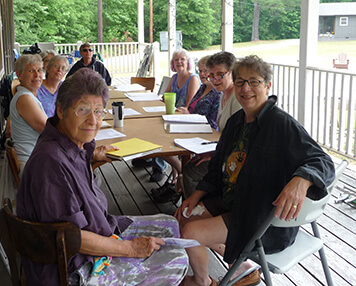
MM: You started with the interviews. Tell about that. Tell about what made you decide that interviewing was the way to go, and to stop asking women to write their own stories.
RN: Well, I’ll say it was Jessica Lancia, who came to Womonwrites in 2010 to do interviews with lesbians. She was a doctoral student in the University of Florida Oral History Program. She interviewed me, among other women. She also came to the Herstory Project workshop, and she talked about interviews, recommending the Zoom digital recorder for interviews. I was thinking about video interviews because I had borrowed a video camera to do interviews at the 20th Womonwrites in 1998; and again, to record readings and other Womonwrites scenes in 1999, which was our twentieth year. Those digitized videos and the original tapes are now archived at Duke. I was thinking that it would be fun. I’m not an interviewer. I’m not an oral historian. I’m not even a historian. You know, I’m trained in English.
MM: So you say!
RN: I do like women’s autobiography. That was the subject of my dissertation, and it’s one of my strong interests. We got Jessica to do a workshop later on about collecting oral histories. That’s when I bought the Zoom recorder. It wasn’t until 2012 that I decided that I wanted to do go on the road doing interviews although I was thinking about it in 2010. Workshop notes say, “Rose wants to travel and collect video interviews.” That was the year I retired, August 2010. I didn’t actually go on the road until 2012. I went to Gainesville, Florida, because we knew that Gainesville was a hotbed of lesbian-feminist activism.
Corky Culver was the instigator of a lot of that activism, and very knowledgeable about it. She also owned a video camera. She recorded many, many events in that area. Her video collection, 1960 to 2010, is now archived at the Lesbian Home Movie Project.
[“Corky Culver’s Collection includes three, early, super 8mm films, and 128 Hi 8 & mini dvd tapes, spanning her adult life to date. Her initial intention was to gather material for a single documentary. At this point, her collection includes enough raw material for several.”]
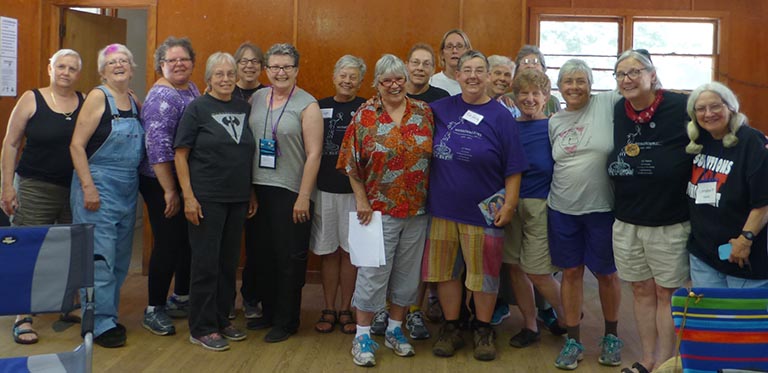
Corky also has a PhD in English, and she has an academic background. But she’s also an old-time Landdyke from the 1960s, who was part of starting the first lesbian consciousness-raising group, maybe the first one in the country. This was in 1969 in Gainesville, Florida. Carol Hanisch and Kathy Sarachild were both living there. Neither of them is lesbian-identified. They encouraged consciousness-raising groups. [Carol Hanisch wrote the famous story that was later named, “The Personal is Political.”]
Carol and Kathy were both members of the New York Radical Women’s group. They were both involved in starting consciousness raising groups around the country. At that time, they were dividing their time between Gainesville and New York City. Corky was close to them, and she learned a lot from them.
MM: Corky was an old-timey, radical activist even way before then.
RN: Corky’s lesbian CR group decided they needed land, and they started the North Forty in Florida, which was the earliest women’s land community that I know about in the country. That was in 1972. WeMoon Land out in Oregon was the second women’s land community in 1973, and they were kind of overlapping. In a way, they sort of share “first-ness.” They are both still today women’s land. Both lands still have women living on the land after 50 years. It’s 52 years now for the North Forty.
Corky hosted me when I went to Gainesville, Florida. I stayed with Corky, interviewing her every night. She was going through all of her papers, and she told me about a lot of lesbians to interview. From Corky, I learned a lot about Gainesville and the Women’s Liberation Movement.
A year or so later, Barbara Ester suggested that we contact Sinister Wisdom to see if they were interested in publishing some of this.
MM: That would be great. I remember that workshop when Barbara said that, and it was like dawn breaking. But would Sinister Wisdom do it?
RN: I went to my computer to email Sinister Wisdom that day, I got a reply while we were still at Womonwrites. They were interested. That really shaped what we did for the next ten years on the Herstory Project. Our first Sinister Wisdom issue was 2014.
One thing that I wanted to mention is that in the beginning is that the whole idea of transcribing recordings was daunting. I did not want to transcribe these things word for word. I just didn’t. All I wanted was the stories. We didn’t have any money, and I wasn’t ready to pay a transcriber out of my pocket. We didn’t have a budget. I wasn’t going to ask for travel money. Traveling to collect stories was what I wanted to do. And it was fun.
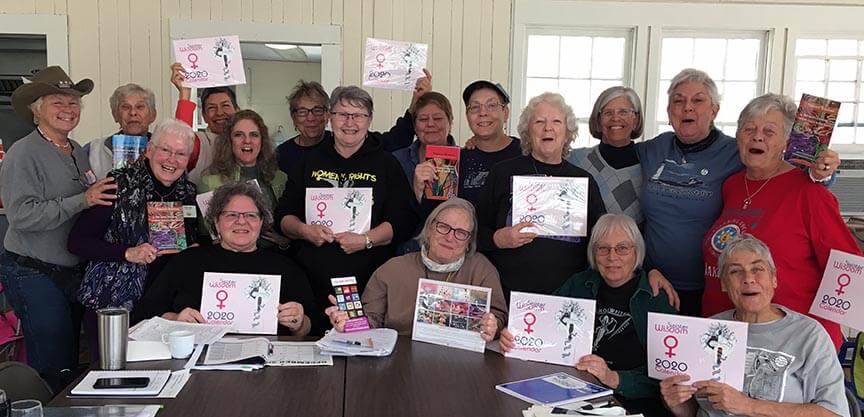
The Feminist Approach
Until we started the website, there was no money involved. We still don’t have any kind of legal entity. We do have a bank account now because we needed some money for the website. We’ve been talking about grants, trying to find grants, ever since probably 2012. Several of us have experience with grant writing, and that’s probably why none of us wanted to jump into it. (It’s hard.)
MM: It’s very lesbian feminist for us to function the way we do. It’s all volunteers, and the only person that gets paid is Susan, who does the website, because that’s her profession. And website design takes a lot of time and skill. She gets underpaid for that anyhow.
This way, we don’t have to follow anybody else’s rules, which you’re obligated to do when you get money from other places. Yes, it would be nice to have better equipment. Maybe someday somebody will endow us with the things that we need. The women that are doing the interviewing can ask for the equipment of their choices. They can be free and clear with no rules to follow that might hinder us.
“This interview has been edited for archiving by the interviewer and interviewee, close to the time of the interview. More recently, it has been edited and updated for posting on this website. Original interviews are archived at the Sallie Bingham Center for Women’s History and Culture in the David M. Rubenstein Rare Book and Manuscript Library at Duke University in Durham, North Carolina.”
See Also:
Merril Mushroom and Rose Norman, “Womonwrites,” Sinister Wisdom 93 (Summer 2014): 127-132.
Rose Norman, Merril Mushroom, and Kate Ellison. “Womonwrites–Lesbian Feminist Cultural Cauldron.” Sinister Wisdom 116 (Spring 2020): 88-92.
Sheila Grace Shook, “Womonwrites,” Sinister Wisdom 116 (Spring 2020): 93-95.
The Southern Lesbian Feminist Activist Herstory Collection in Sinister Wisdom 124 (Spring 2022): 181-86.
Southern Lesbian Feminist Activist Herstory Project Virtual Celebration, May 24, 2022.
